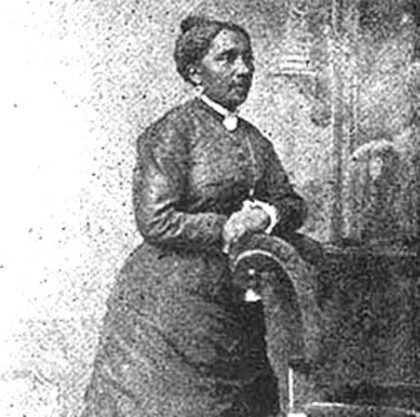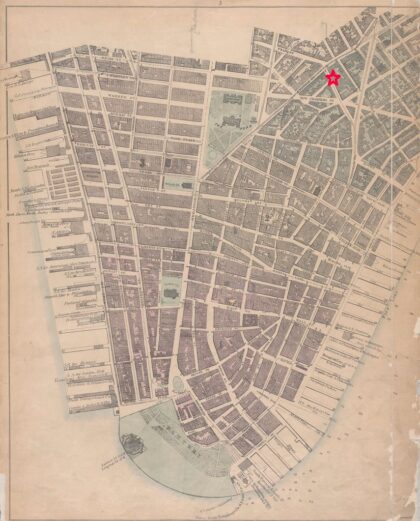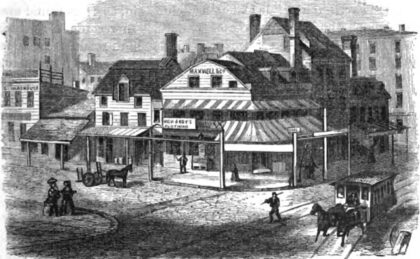Honoring the woman who desegregated the city’s transportation system
CB1’s Waterfront, Parks and Cultural Affairs Committee will be considering a plan for a monument for Elizabeth Jennings Graham, the Black woman credited with ending segregated streetcars in New York City, and of course the history is both amazing and completely overlooked. This seems like an excellent tribute and one that actually have some funding to make it happen.
Graham, a school teacher, was running late on her way to church on July 16, 1854, when the conductor of a whites-only street car kicked her off at the corner of what was Pearl and Chatham, telling her to wait for the next car, which allowed Blacks to ride. She refused and was roughed up by the conductor, the driver and the police. She published a letter to the editor about the incident, Black New Yorkers rallied around her, and her father, a prosperous tailor on Church Street who invented a dry cleaning machine and who was also a prominent abolitionist, hired a lawyer to sue the Third Avenue Rail Road.
It turned out the lawyer was a 26-year-old Chester A. Arthur, who would go on to succeed James Garfield as president in 1881. And it turned out this was his first-ever case. And, it turns out, they won.
“Truly amazing,” said Jacob Morris, who runs an organization called the Harlem Historical Society and who is giving the presentation to CB1. “She was responsible for the desegregation of the street cars — in other words public transportation in New York City — that’s amazing. And in 1854? A hundred years before Rosa Parks refused to give up her seat in Alabama. As New Yorkers, we should be proud of that.”
To understand the history behind Graham, Morris has worked with Jerry Mikorenda, whose book, “America’s First Freedom Rider — Elizabeth Jennings, Chester A. Arthur, and the Early Fight for Civil Rights,” explains the whole store. (Mikorenda will also be at the CB1 presentation on Sept. 20.) And the two of them played a role in nominating Graham to be recognized by She Built NYC, former NYC first lady Chirlane McCray’s program to memorialize women historical leaders in a city monument (only five out of New York City’s 150 statues of historic figures depict women). Six women were chosen in a years-long process, and the area around Grand Central Station was designated as a site for the statue for Graham. The program *should* still be bankrolled as well.
But wait! There’s more. She Built NYC targeted Grand Central Station for the location of the memorial, which CB5 rejected since there’s no geographical connection there. And Morris agrees.
“She had nothing to do with Grand Central Terminal — in fact it wasn’t even built then,” Morris says. “So does she deserve a monument? A million percent. Should it be in the general vicinity of where she got thrown off the street car, just as Rosa Parks’ monument is in Montgomery? The answer to me is absolutely yes.”
Of course the intersection of Pearl and Chatham has been wiped off the city grid, but something nearby — Morris is thinking maybe the plaza behind One Centre — would work well.
“You could reflect on many things if the monument was there,” said Morris, “including how the streetscape of New York has changed.”
And to whet your appetite, here’s the publisher’s summary of Mikorenda’s book:
In 1854, traveling was full of danger. Omnibus accidents were commonplace. Pedestrians were regularly attacked by the Five Points’ gangs. Rival police forces watched and argued over who should help. Pickpockets, drunks and kidnappers were all part of the daily street scene in old New York. Yet somehow, they endured and transformed a trading post into the Empire City.
None of this was on Elizabeth Jennings’s mind as she climbed the platform onto the Chatham Street horsecar. But her destination and that of the country took a sudden turn when the conductor told her to wait for the next car because it had “her people” in it. When she refused to step off the bus, she was assaulted by the conductor who was aided by a NY police officer. On February 22, 1855, Elizabeth Jennings v. Third Avenue Rail Road case was settled. Seeking $500 in damages, the jury stunned the courtroom with a $250 verdict in Lizzie’s favor. Future US president Chester A. Arthur was Jennings attorney and their lives would be forever onward intertwined.
This is the story of what happened that day. It’s also the story of Jennings and Arthur’s families, the struggle for equality, and race relations. It’s the history of America at its most despicable and most exhilarating. Yet few historians know of Elizabeth Jennings or the impact she had on desegregating public transit.




















What an incredible story!! If there is a campaign to fund a memorial for this amazing lady, I would be happy to contribute. I hope she gets the recognition she certainly deserves..
If not behind the David Dinkins/Municipal building then City Hall Park NE Plaza, 4-5-6 station, where there is even more transit activity and tourist traffic!